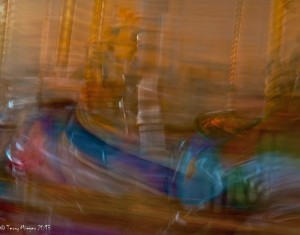Images from the Id-Photographic Vision
Image Title- Ghost Ride on a Carousel – Santa Monica Pier
A few days ago, I was walking through the Plaza in Santa Fe considering writing this blog and a couple stepped up, each with their own iPad, and took a picture. Is there really a difference between my images, we don’t say pictures anymore, and their’s? My thousands-of-dollars of equipment and their multitaskers? It might be more or maybe less than you think. What is a photograph? Why are we photographers?
I need to make a few assumptions about us photographers. First, we have some desire to take better pictures (I like pictures here better than images). Second, we are motivated to improve. OK, maybe some of us are more “driven” than others. Third, we all think of equipment as being the most important part and we are all wrong, or mostly wrong
As for equipment. To quote Bill Murray (Meatballs 1979) “It doesn’t really matter” or does it?
The most important piece of equipment is the mind of a photographer:
It’s the mind that really counts- your mind and not anyone else’s mind. Hopefully, we all have one but do we know how to use it “like a photographer”? Most minds start out as unperceptive, little lumps of white and gray matter that act a little like a sponge and start soaking up all that is good and bad around them. That is why my definition of mind includes the sensory connections to the world. As a prospective photographer, we must train the mind to see things differently. Minds, following the Law of Entropy, would rather learn bad things not good and they don’t like being told what to do. Think about (Did I say that?). So get your ducks in a row or duck in a row, sort of like clapping with one hand? Is that why we would snap our fingers in the 60’s? BOT (back on topic). Vision is the most important and you can train your Id, sub-conscience.
You have probably noticed that my mind is it goes anywhere it wants. I have little control but that is actually good when thinking like a photographer. That’s the point. Shoot differently, shoot to show others your perception of the Universe. It makes no difference what camera you are using if you don’t “see” the shot. Learn to look at angle perspective light, what can be called composition. At this point might expect information about following “The Rules”. Rules make good images. Knowing when to break the rules can make great images. Yes we’ll talk about rules, learn them well and when to break them.
Your “Vision” is different and not not well understood by others. It includes part of your soul and who you are. Remember you are not what other think your are. It is your difficulty to communicate yourself in your images. Everything you work on is to show that Vision.
Next the other equipment and how it relates to your “vision”


